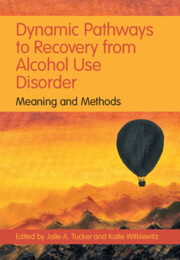Book contents
- Dynamic Pathways to Recovery from Alcohol Use Disorder
- Dynamic Pathways to Recovery from Alcohol Use Disorder
- Copyright page
- Dedication
- Contents
- Figures
- Tables
- Contributors
- Foreword
- Preface
- Acknowledgments
- Introduction
- Part I Micro Level
- 2 Biopsychosocial Process of Change in Alcohol Use Disorder Recovery
- 3 The Role of Self-Regulation Strategies in Recovery from Alcohol Use Disorder
- 4 Neuropsychological and Biological Influences on Drinking Behavior Change
- 5 Lifespan Developmental Perspectives on Natural Mechanisms of Cessation of Risky Alcohol Use and Recovery from Alcohol Use Disorder
- 6 Mutual Help Approaches and Mechanisms of Change
- 7 Time-Varying Effect Modeling to Examine Recovery Outcomes across Four Years
- 8 Latent Variable Mixture Modeling Approaches to Investigating Longitudinal Recovery Processes
- Part II Meso Level
- Part III Macro Level
- Conclusions and Future Directions
- Index
- References
7 - Time-Varying Effect Modeling to Examine Recovery Outcomes across Four Years
from Part I - Micro Level
Published online by Cambridge University Press: 23 December 2021
- Dynamic Pathways to Recovery from Alcohol Use Disorder
- Dynamic Pathways to Recovery from Alcohol Use Disorder
- Copyright page
- Dedication
- Contents
- Figures
- Tables
- Contributors
- Foreword
- Preface
- Acknowledgments
- Introduction
- Part I Micro Level
- 2 Biopsychosocial Process of Change in Alcohol Use Disorder Recovery
- 3 The Role of Self-Regulation Strategies in Recovery from Alcohol Use Disorder
- 4 Neuropsychological and Biological Influences on Drinking Behavior Change
- 5 Lifespan Developmental Perspectives on Natural Mechanisms of Cessation of Risky Alcohol Use and Recovery from Alcohol Use Disorder
- 6 Mutual Help Approaches and Mechanisms of Change
- 7 Time-Varying Effect Modeling to Examine Recovery Outcomes across Four Years
- 8 Latent Variable Mixture Modeling Approaches to Investigating Longitudinal Recovery Processes
- Part II Meso Level
- Part III Macro Level
- Conclusions and Future Directions
- Index
- References
Summary
This chapter introduces readers to the use of time-varying effect modeling (TVEM), a statistical tool for capturing dynamic changes over time, as applied to the study of substance use disorder recovery processes. The chapter presents an empirical demonstration of using TVEM to examine the effect of an intervention, Recovery Management Checkups (RMCs), on substance use and key features of the ongoing process of recovery (life satisfaction, cognitive avoidance, self-efficacy) as a continuous function of time. The example application data come from the Early Re-Intervention experiment of 446 adults from a large addiction treatment agency who were randomly assigned to receive RMCs or an assessment control. Given the time-varying nature of the effect of the RMC on recovery outcomes and the differential patterns observed by type of outcome, TVEM may be a viable option in lieu of or in addition to using common metrics of “treatment success.” SAS syntax is provided.
Keywords
- Type
- Chapter
- Information
- Dynamic Pathways to Recovery from Alcohol Use DisorderMeaning and Methods, pp. 114 - 136Publisher: Cambridge University PressPrint publication year: 2022
References
- 2
- Cited by

